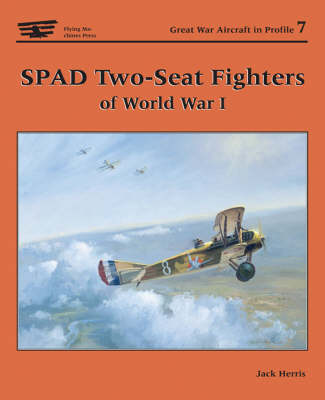Flying Machines Press
2 total works
Societe Anonyme pour Aviation et ses Derives (SPAD) was a French aircraft manufacturer between 1911 and 1921. Its SPAD S.XIII biplane was the most popular French fighter airplane in the World War I.
The company was set up in 1911 as the Societedes Aeroplanes Deperdussin, becoming the Societe Provisoire des Aeroplanes Deperdussin in 1912. Founder Armand Deperdussin (1867-1924) had been a travelling salesman and a cabaret singer in Liege and Brussels, before making his fortune in the silk business. Deperdussin became fascinated by aviation in 1908, and in 1909 he established an aircraft works at Laon. Deperdussin himself was not a noted designer, but he hired the talented engineer Louis Bechereau (1880-1970) as technical director. Bechereau would be responsible for SPAD aircraft designs thereafter.
SPAD was one of the most important aircraft manufacturers during World War I, but until now the focus of published materials about it has been on its two most famous single-seat designs, the SPAD 7 and SPAD 13. This new book takes a look at SPAD's less well known two-seat designs, including the SPAD SA series, the widely used SPAD 11 and SPAD 16, and the excellent SPAD 20, which arrived just before the war ended.
The latest addition to the Flying Machine Press library, SPAD Two-Seat Fighters of World War I has the most extensive coverage-history, evolution, combat use, photos, colour profiles, and scale drawings-of these aircraft ever published.
Eagerly awaited by World War I aviation buffs and modellers, this volume is an important contribution to the history of SPAD aircraft.
The company was set up in 1911 as the Societedes Aeroplanes Deperdussin, becoming the Societe Provisoire des Aeroplanes Deperdussin in 1912. Founder Armand Deperdussin (1867-1924) had been a travelling salesman and a cabaret singer in Liege and Brussels, before making his fortune in the silk business. Deperdussin became fascinated by aviation in 1908, and in 1909 he established an aircraft works at Laon. Deperdussin himself was not a noted designer, but he hired the talented engineer Louis Bechereau (1880-1970) as technical director. Bechereau would be responsible for SPAD aircraft designs thereafter.
SPAD was one of the most important aircraft manufacturers during World War I, but until now the focus of published materials about it has been on its two most famous single-seat designs, the SPAD 7 and SPAD 13. This new book takes a look at SPAD's less well known two-seat designs, including the SPAD SA series, the widely used SPAD 11 and SPAD 16, and the excellent SPAD 20, which arrived just before the war ended.
The latest addition to the Flying Machine Press library, SPAD Two-Seat Fighters of World War I has the most extensive coverage-history, evolution, combat use, photos, colour profiles, and scale drawings-of these aircraft ever published.
Eagerly awaited by World War I aviation buffs and modellers, this volume is an important contribution to the history of SPAD aircraft.
Pfalz Flugzeugwerke was a World War I German aircraft manufacturer, located at the Speyer airfield in the Rhineland-Palatinate. They are best known for their series of fighters, notably the Pfalz D.III and Pfalz D.XII. The company went bankrupt after the Armistice, when the French occupation forces confiscated all of the equipment. Pfalz was the brainchild of Alfred Eversbusch, son of a foundry owner in Neustadt an der Weinstrasse. It appears that he had built his own aircraft between 1912 and 1913, although the exact origin of the design is unclear. On June 3, 1913, the Pfalz company was registered, consisting of Alfred, his brother Ernst, and his brother-in-law Willy Sabersky-Mussigbrodt, as well as several investors: Richard and Eugen Kahn, and August Khan.
Pfalz Aircraft of World War I is the most comprehensive coverage of this German fighter series ever published.
Every Pfalz design is detailed, from the early two seaters and prototypes through the classic D.III, D.VIII, and D.XII fighters that saw combat on the Western Front. The book is filled with more than 320 photos, many of operational aircraft and their markings, that have never before been published. It includes a lavish, 18-page color section illustrating 62 aircraft, including many that have never before been portrayed in color, as well as excellent five-view scale drawings of 15 Pfalz designs to standard modelers' scales of 1/48 and 1/72.
Pfalz Aircraft of World War I is the most comprehensive coverage of this German fighter series ever published.
Every Pfalz design is detailed, from the early two seaters and prototypes through the classic D.III, D.VIII, and D.XII fighters that saw combat on the Western Front. The book is filled with more than 320 photos, many of operational aircraft and their markings, that have never before been published. It includes a lavish, 18-page color section illustrating 62 aircraft, including many that have never before been portrayed in color, as well as excellent five-view scale drawings of 15 Pfalz designs to standard modelers' scales of 1/48 and 1/72.

